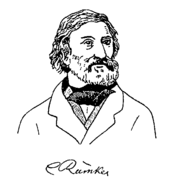Carl Ludwig Christian Rümker

Carl Ludwig Christian Rümker (28 May 1788 – 21 December 1862) was a German astronomer. His name in German is spelled, Karl Ludwig Christian Rümker; he was also known as Charles Rümker, Charles Rumker, Charles Luis Rumker, Christian Carl Ludwig Rümker and Dr. Charles Stargard Rumker.
Early life (1788-1821)
Rümker was born in Burg Stargard, in Mecklenburg, Germany, the son of J. F. Rümker, a court-councillor.[1] He showed an aptitude for mathematics and studied at the Builders' Academy, Berlin, graduating in 1807 as a master builder. Instead of a career in building, he taught mathematics in Hamburg until 1809 when he went to England.
Rümker served as a midshipman in the British East India Company and then in the British merchant navy from 1811 until 1813. In July 1813 he was seized by a pressgang and joined the Royal Navy. He served in the Royal Navy as a schoolmaster until 1817 on HMS Benbow, Montague and Albion taking part in the expedition to Algiers 1816 whilst on the Albion. In 1817 he met Austrian astronomer Baron Franz-Xaver de Zach, who influenced Rümker to study astronomy.[1] Rümker was director of the school of navigation at Hamburg from 1819 until 1820.
Life in New South Wales (Australia) (1821-1830)
In 1821 Rümker went to New South Wales as astronomer at the observatory built at Parramatta by Sir Thomas Brisbane. James Dunlop was second assistant. Rümker was awarded the silver medal of the Royal Astronomical Society together with £100, for his re-discovery of Comet Encke on 2 June 1822 and also received the gold medal of the Institut de France.[1]
In June 1823 having fallen out with Brisbane he left the observatory. He had been granted 1,000 acres (4.0 km2) of land on the west side of the Nepean River on the assurance that he would devote his time to scientific pursuits. Brisbane in a dispatch to Henry Bathurst, 3rd Earl Bathurst in November 1823 requested that the grant should not be confirmed beyond 300 acres (1.2 km2) because Rümker had "completely broken" his promise.[2] Bathurst, however, refused Brisbane's request, realizing that this would be a case of one man's word against another's if it were further investigated. After Brisbane's departure Rümker was placed in charge of the observatory by the government in May 1826, Rümker being the first to hold the title of government astronomer. It was intended that Rümker should measure the arc of the meridian; however it would have been necessary to obtain instruments from London and Rümker left the colony in January 1829.
The results of his observations at Parramatta were published in Part III of the Philosophical Transactions of the Royal Society for 1829 and in the Royal Astronomical Society's Memoirs, Vol. III. Rümker also contributed an article to the Geographical Memoirs of New South Wales, edited by Barron Field, the first collection of scientific papers published in Australia. While in England, Rümker quarrelled with James South, president of the Royal Astronomical Society, who dismissed Rümker from British government service.[1]
Life in Hamburg, Germany (1830-1857)
Rümker returned to Europe in 1830 and took charge of the new Hamburg Observatory after the death of Johann Georg Repsold in 1830. His chief work was concerned with the cataloging of stars: a preliminary catalogue of the stars of the Southern Hemisphere was published in 1832 at Hamburg, and from 1846 to 1852 he published his great catalogue of 12,000 stars. He served as the director of Hamburger Sternwarte then located at Stadtwall and funded by the city of Hamburg as Christian Karl Ludwig Rümker from 1833 to 1857.[1]
Final years & Legacy (1857-1862)
In 1857, Rümker resided at Lisbon, Portugal, where he died in 1862. His son was also an astronomer, Georg Friedrich Wilhelm Rümker, who was born in 1832, at Hamburg. He took over as director of Hamburger Sternwarte in 1857, where he served until his death in 1900. The Hamburger Sternwarte at Millerntor site was demolished when the observatory moved to Bergedorf under the direction of Richard Schorr for better astronomical seeing (the telescopes were moved), and the area eventually became the location the hamburgmuseum.[3] From 1901 to 1922 the new Hamburg observatory at Bergedorf renewed the observation of Rümker's catalog with its 12000 star. The catalog Carl Rümkers Hamburger Sternverzeichnis 1845.0 was published in 1923.[4]
Notable writings
- Preliminary catalogue of fixed stars, etc. (1832)
- Handbuch der Schiffahrtskunde (1857)
- Mittlere Örter von 12.000 Fixsternen (1843–1852, 4 parts; new series 1857, 2 parts)
- Längenbestimmung durch den Mond (1849).
Notes
- 1 2 3 4 5 George F. J. Bergman, 'Rümker, Christian Carl Ludwig (1788 - 1862)', Australian Dictionary of Biography, Vol. 2, MUP, 1967, pp 403-404. Retrieved 21 November 2009
- ↑ Historical Records of Australia, ser. I, vol. XI, p. 154
- ↑ Die Hamburger Sternwarte. ("The Hamburg Observatory"), Report on the Hamburg Observatory by R. Schorr, English Translation by Hamburg Observatory
- ↑ J. Schramm, Sterne über Hamburg - Die Geschichte der Astronomie in Hamburg, 2nd edition, Kultur- & Geschichtskontor, Hamburg 2010, ISBN 978-3-9811271-8-8
References
- Dr. Charles Stargard Rumker at Astronomical and Meteorological Workers in New South Wales
- George F. J. Bergman, 'Rümker, Christian Carl Ludwig (1788 - 1862)', Australian Dictionary of Biography, Volume 2, MUP, 1967, pp 403–404
- Serle, Percival (1949). "Rümker, Karl Ludwig Christian". Dictionary of Australian Biography. Sydney: Angus and Robertson.
External links
 "Rümker, Carl Ludwig Christian". Encyclopædia Britannica (11th ed.). 1911.
"Rümker, Carl Ludwig Christian". Encyclopædia Britannica (11th ed.). 1911.